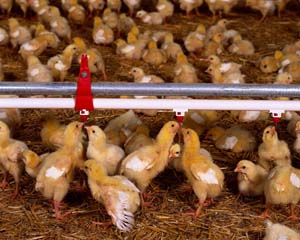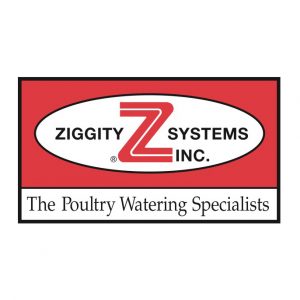Achieving optimal water pressure in the poultry house

One of the most important and misunderstood jobs a producer must perform in the poultry house is to maintain the correct pressure in the watering lines. This article reviews tips that will help producers achieve the optimal water pressure for systems and flocks.
By Ziggity Systems , Middlebury, Indiana, USA
Water coming to the poultry house usually has a pressure of 20 to 40 psi (1.4 to 2.8 Bar). That is simply too high. Pressure this high can damage the system, causing drinkers to leak and spray water. Also, the birds cannot activate the trigger pins on the drinkers with pressure this high.Because of this, all enclosed watering systems have pressure regulators. A regulator allows the producer to decrease the pressure in the drinker line to a level that will provide the birds with all the water they need to thrive, but not too much that the system will over-deliver water and wet the litter.
Guidelines for producers
There are a number of guidelines that producers can follow to achieve the optimal water pressure for systems and flocks.
There are a number of guidelines that producers can follow to achieve the optimal water pressure for systems and flocks.
No two flocks are the same. What worked well for one flock can produce disastrous results for the next. The pressure in the system must be managed to reflect the conditions in the poultry house.
Manufacturer guidelines are not precise rules. Most manufacturers of enclosed nipple-type watering systems issue guidelines on the pressure settings to use. These, however, are just recommendations, and each producer must manage according to observed conditions, not according to specific preset pressure settings.
Litter conditions are key. Litter readings are the most reliable method for determining the correct pressure setting. The litter beneath the drinkers should be dry and friable. That means when you grab a handful of litter and squeeze, the litter should clump together briefly and then fall apart. If it remains in a clump, the litter is too wet and the water pressure is probably too high. If it will not clump at all, the litter is too dry and the water pressure is probably too low.
High water pressure doesn’t mean more water consumed. The higher the water pressure, the more water the drinkers will discharge, but that does not mean more water goes to the birds. Birds can only consume so much; if you keep raising the pressure the excess water goes into the litter.
Warm weather requires more water delivery. As the weather warms, your birds will drink more, requiring increased water pressure. The reason for the increased consumption is to help the birds regulate their body temperatures. Birds do not have sweat glands and will pant to blow off excess heat. The panting causes water loss through the lungs.
Cold weather requires less water delivery. Conversely, birds consume less water in cooler weather. Leaving the water pressure at warm weather levels causes an over delivery to the drinkers. This results in wet litter and significant problems that accompany that condition.
Broilers consume more water as they age. Therefore, the system requires constant adjustments to water pressure as birds mature to ensure they get all the water needed without an oversupply.
Delivering more water cannot force a bird to eat more. There is a direct correlation between the amount of water a bird consumes and the amount of food it consumes. Broilers drink about 1.6 to 1.8 lbs. (0.7 to 0.8 kg) of water for every pound (0.45 kg) of feed they consume. However, you cannot force a bird to eat more simply by turning up the water pressure. A bird can consume only the water it can hold in its beak. Any excess will result in spillage and wet litter.
Pressure may not be even throughout the house. If the line is level, the pressure in the line is constant throughout. If the line is not level, the pressure will be greater in the downhill portion of the house. This can cause wet litter in portions of the house. Slope neutralisers should be installed in each drinking line to help even out the pressure in the house.
Be vigilant in your pressure-setting process. Follow industry guidelines for achieving and maintaining optimal water pressure and litter conditions. Following these procedures will help keep litter dry and improve performance results.
MORE INFORMATION













